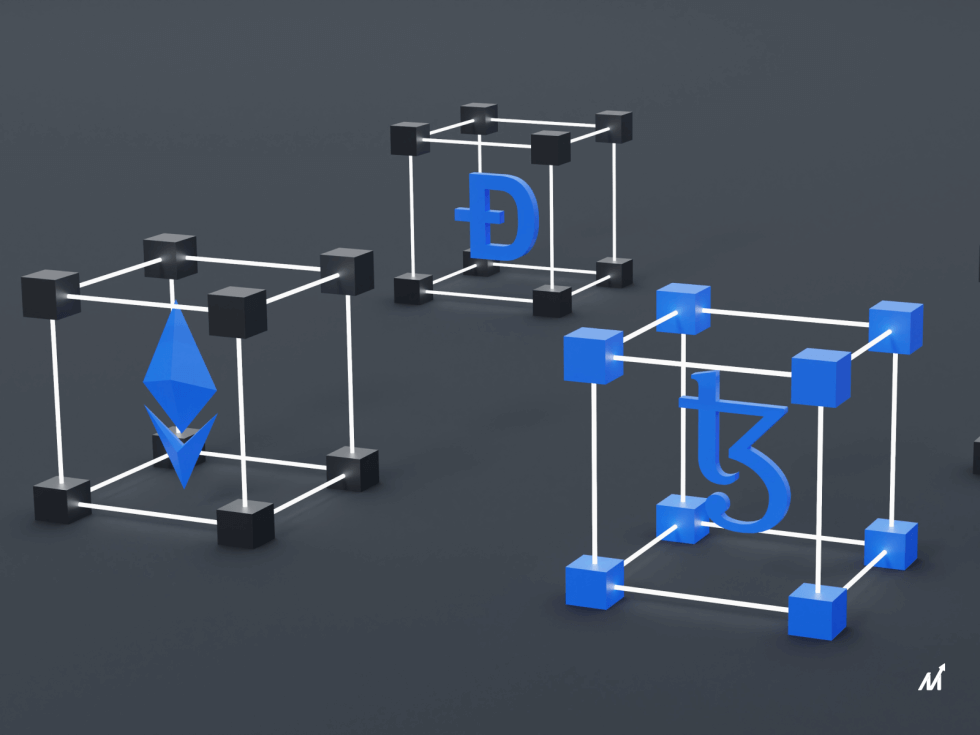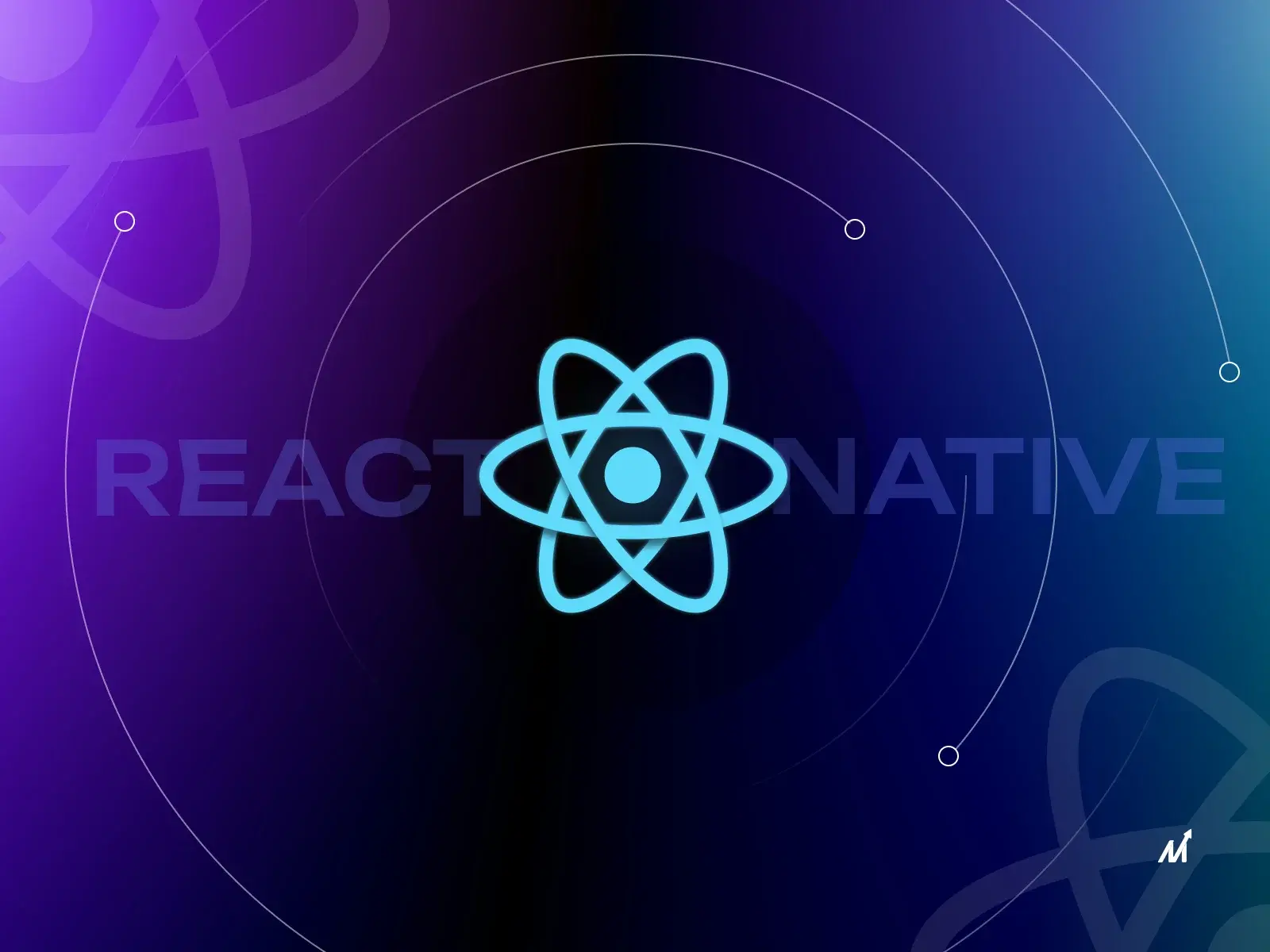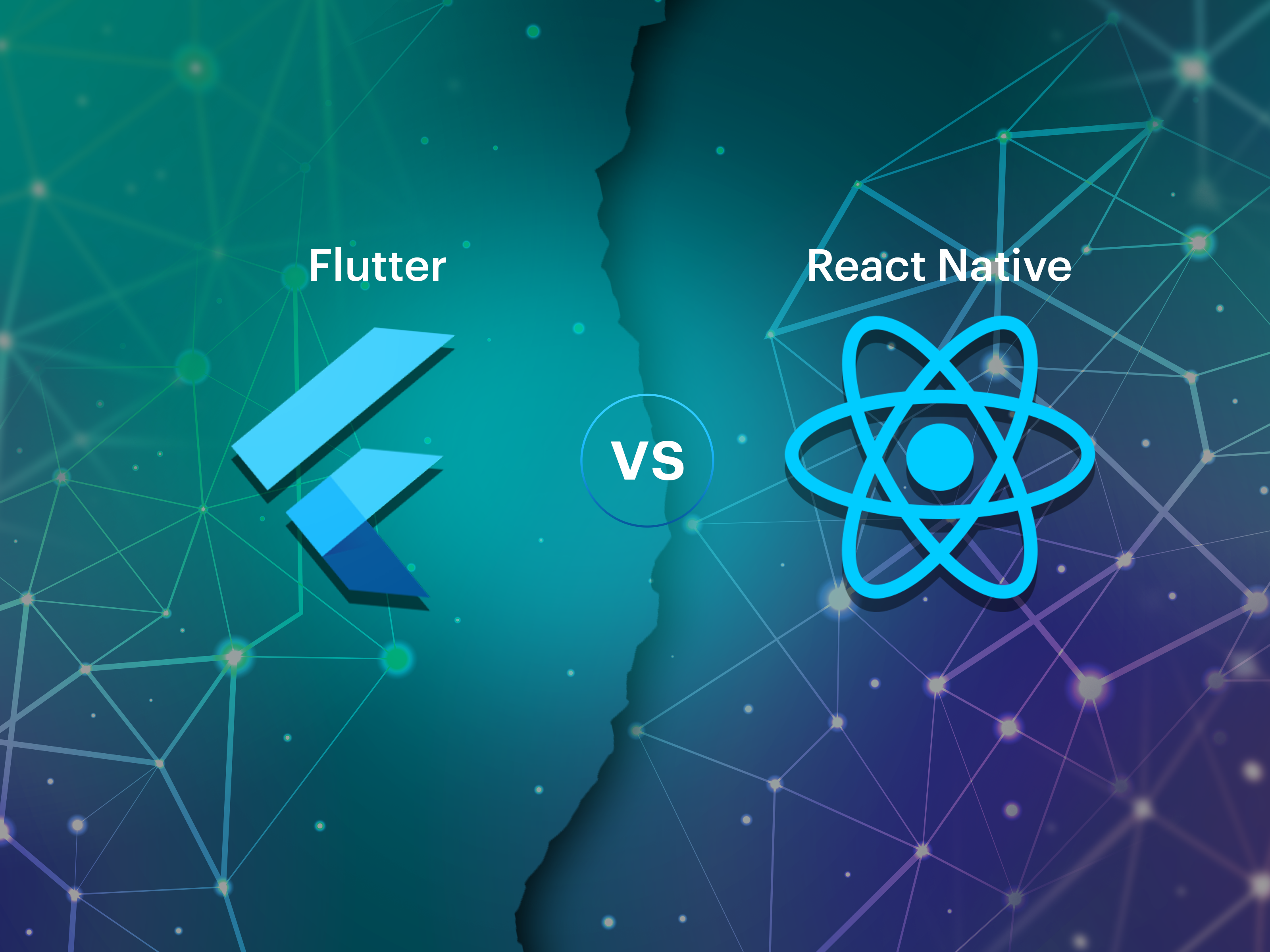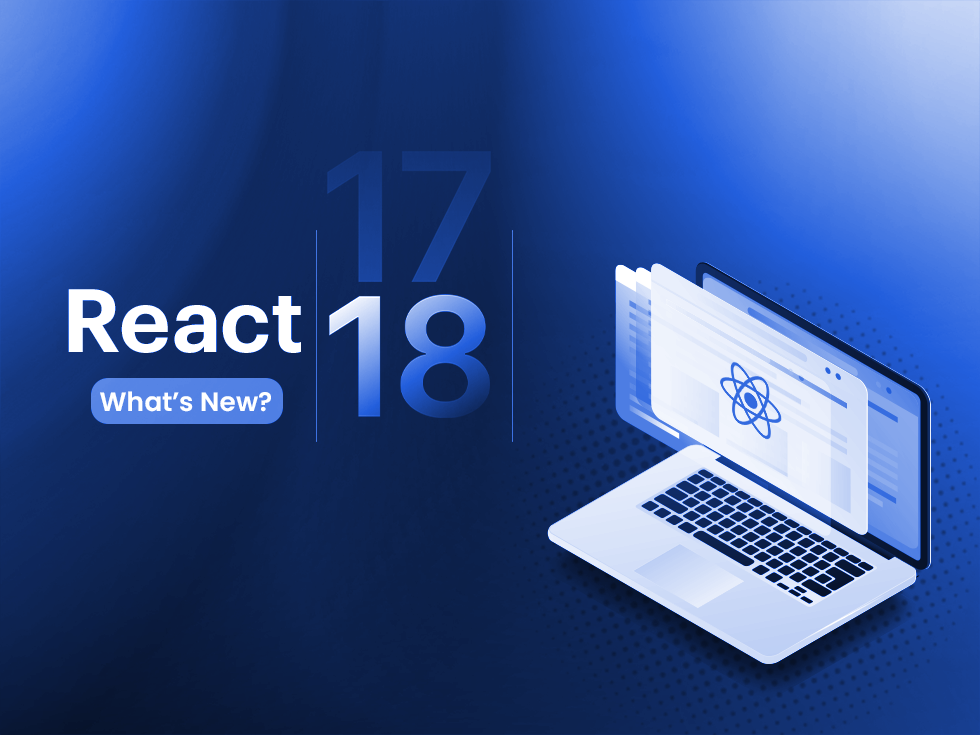Blockchain Mobile App Development: Introduction
The blockchain technology market is anticipated to reach 04 Billion in 2027, representing a CAGR of more than 56%. These numbers speak magnitudes about blockchain apps and their future. But what exactly is blockchain? A blockchain is a computer network linked together and serves as a distributed record of transactions. Several transactions are contained in each block of the chain. A description of the details of each new transaction is uploaded to each participant’s blockchain every time it is made.
Blockchain is a cutting-edge method of storing data that makes hacking or vandalizing the system impossible. Read below to learn more about blockchain mobile app development, dApp development platforms, and blockchain app technologies.
Blockchain Mobile App Development: Working & Technicalities
Blockchain technology is a framework for storing public transactional records (aka ‘blocks’) across several databases in a network connected by peer-to-peer nodes. This storage type is frequently called a ‘digital ledger.’ Any transaction of data will be stored on the blockchain. As a result, every data transaction has a place in the log, similar to a ledger system. More specifically, the system’s data transfers are referred to as transactions. Once the transaction has been validated, a block is created for it in the ledger system.
Blockchain Mobile App Development: Step by Step Overview
Determining the scope and goal of the application is a necessary step in creating any blockchain apps or tokens. It may be a token like Bitcoin, a real estate smart contract, or something else entirely. So let’s examine these actions that may make blockchain mobile app development smoother.
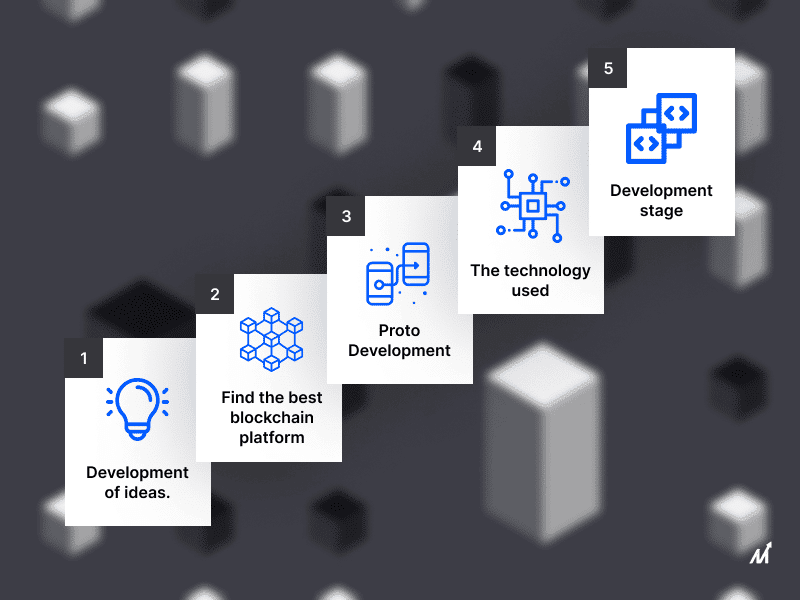
1. Development of Ideas
Deciding on why you want to utilize blockchain is the first step.
You must determine the use cases for the application and whether or not your concept needs blockchain. It is vital to remember that blockchain is a method of verifying transactions and encrypting data; if poorly designed, it cannot ensure further transaction security.
Once you’ve concluded that blockchain technology is necessary for your project, you must understand that blockchain mobile app development costs a lot. This is because a blockchain application may be created in several methods, each of which has a different cost and functionality. For example, Suppose you’re a real estate agent trying to construct a blockchain-based supply chain software that maintains a ledger of every property you sell. In that case, you should comprehend the program’s many use cases and how they will benefit your company and the consumer.
2. Find the Best Blockchain Platform
Once you’ve decided that your company must adopt blockchain technology, you must choose the perfect system or technology to use. There are two approaches you may take.
Create a new blockchain
You can design your new blockchain framework, in which you would be in charge of choosing the tech stack, the algorithms, the transaction validation, and the token transaction fee. This one is the most thorough but expensive blockchain mobile app development method. In essence, you are considering producing another Bitcoin or Ethereum, which, although seeming profitable, can cost you upwards of hundreds of dollars. Typically, you would only choose this option if you were developing your cryptocurrency.
Clone well-known blockchain platforms
A more effective alternative to creating a blockchain-based application is to use a well-known blockchain platform. Due to the open-source nature of these platforms, you are free to fork their code repositories and install them under your servers. Should the world embrace, a blockchain you invented is the key question to ask. Keep in mind that the volume of nodes in the network that can validate transactions determines the success of a blockchain platform. Ethereum, Hyperledger Fabric, and Hyperledger SawTooth are a few prominent platforms. However, everyone has specific qualities that can aid in their decision-making.
Utilize tokens on current blockchain systems
This point differs somewhat from the one before. In the previous section, we were emulating the entire blockchain platform and installing it on our servers, assuming we would have an adequate number of network nodes to “mine” the transactions. However, we may “simply generate tokens” and then put them on an active blockchain like Ethereum.
These platforms provide pre-built APIs, algorithms, and mining techniques that may be quickly integrated into your application to utilize blockchain technology (Blockchain as a Service). In addition, since many current wallets support Ethereum tokens, you won’t need to set up a new wallet for your tokens or transactions. This is comparable to setting up your online store on Shopify. Users simply need to provide the necessary information to set up their stores on Shopify because all e-commerce functionalities are available and ready to use on the platform. Similarly, you may program your custom tokens in Solidity and use them on Ethereum. You can use the current platform’s pre-built services to conduct transactions using your tokens. Do not forget that tokens may either be coins or just smart contracts.
3. Proto Development
Given the high cost of developing a blockchain, it is best to create a prototype application first to ensure everything functions as planned before putting it on a live server or an already-existing blockchain platform like Ethereum.
Decide which portions of the app will be “on-chain” and which portions will be “off-chain” when prototyping. In other words, because you are developing a web or mobile app that leverages blockchain, typical capabilities may work without a blockchain and can be operated on standard cloud hosting. The application’s transactional component will come next, which you’ll presumably place on a blockchain platform.
It should also be decided whether your app (or portions of it) will be developed in a permissioned or permissionless network.
Permissionless networks. Anyone may sign up and begin verifying here. The most popular examples are the Ethereum and Bitcoin networks.
Permissioned network. In this scenario, only a few users are permitted to check blocks, and the network owner determines who may join the network. The consensus processes may be identical to those in a permissionless network or entirely original (e.g., authority based).
On-chain and off-chain APIs should be kept apart because they’ll be hosted in distinct locations. Next, select the transaction strategy and consensus methods for your application. This step will be simpler if you use an established blockchain platform because many things are already effectively done on these platforms.
4. Technology Used
The Blockchain app development process covers various types of technologies at each step. Here are a few. These applications aid in blockchain mobile app development.
- Ethereum JavaScript API, web3.js (Documentation)
- dApp browsers include Toshi, Cipher, and Trust for mobile and Mist, Parity, and Metamask for desktop.
- Embark, a framework for serverless, decentralized applications employing platforms like Ethereum, IPFS, and others
- The most well-liked Ethereum programming and testing framework is the truffle.
- Metamask allows you to run Ethereum dApps directly in your browser without running a complete Ethereum node.
- The most sophisticated Ethereum deployment client is Parity.
- Ethereum block explorer Etherscan, used for tracking.
In addition to those mentioned earlier, standard frameworks like react.js, node.js, and native techniques for mobile apps can be utilized for app/server development.
5. Development Stage
The crucial stage of blockchain mobile app development is the final stage. At this point, you should be prepared to create a blockchain application. During this step, you must create or integrate APIs for specific application use cases. The program has numerous versions integrated into it. But, first, a pre-alpha version of the program has not been put through official testing. Once accepted, the application advances to the following stage, known as alpha, when the program is tested using white-box methods by the developers. But at this point, it’s possible that the program doesn’t have all the functions. The software is ready for the beta version when the alpha version is launched. The software application contains all of its features at the beta stage. However, there may be some undiscovered flaws.
To test its functionality, developers distribute the beta version to a specific set of persons outside the company. Next, the program goes to the Release Candidate version. This enhanced beta version is prepared to be a final application and may be deployed once the beta version has been accepted and tested. Finally, the application enters the production stage and prepares for distribution after extensive testing. You should deploy an app on the network system before making it live to test all of its features thoroughly. Administrators may control which program versions should be distributed to different resources when deploying an application using provisioning.
An application must be deployed on the main chain after it has been provisioned. You must deploy your blockchain application to the cloud server, the app store, and the play store if it is a hybrid solution that includes two different off-chain and on-chain business entities. Once developed, a software program must be maintained to guarantee that it will function with all future upgrades.
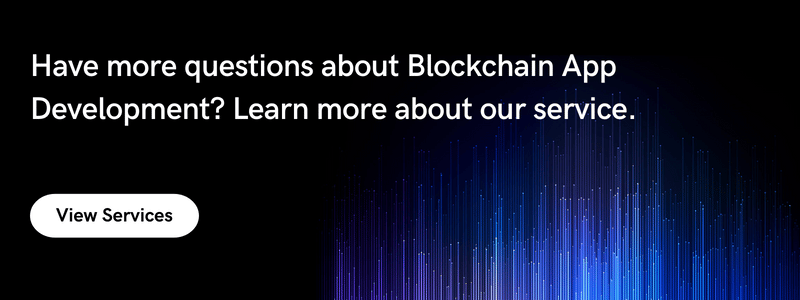
Blockchain Mobile App Development: Platforms for dApp Development
A distributed open-source software program is a ‘decentralized application’ (dApp) and operates on a peer-to-peer (P2P) blockchain network instead of a single computer. dApps are comparable to software programs used on websites or mobile devices but feature P2P. dApps can function on a blockchain network or a P2P network. For instance, BitTorrent, Tor, and Popcorn Time are computer programs connected to a P2P network where several users receive content, feed or seeding information, or do both at once.
Some of the most popular platforms for dApp development are:
1. Ethereum
The Ethereum blockchain platform gives you the resources you need to create dApps, including a sophisticated ‘smart contracts’ paradigm and Solidity, a JavaScript-like programming language with dApp awareness.
The most effective platform for developing dApps is probably Ethereum. Solidity, the language used by Ethereum, enables programmers to create smart contracts using Ethereum Virtual Machine (EVM).
2. EOS
One of the top blockchain platforms for creating decentralized applications is EOS. EOS.IO is a recommended and effective blockchain platform for dApp creation compared to other blockchain platforms. EOS offers dApp developers a straightforward method for hosting applications, carrying out smart contracts, and using other operating system-like functions.
EOS provides the opportunity to create fully functional dApps. Furthermore, it functions as a decentralized platform, allowing anybody to create a decentralized application (dApp) and operate it on the EOS blockchain.
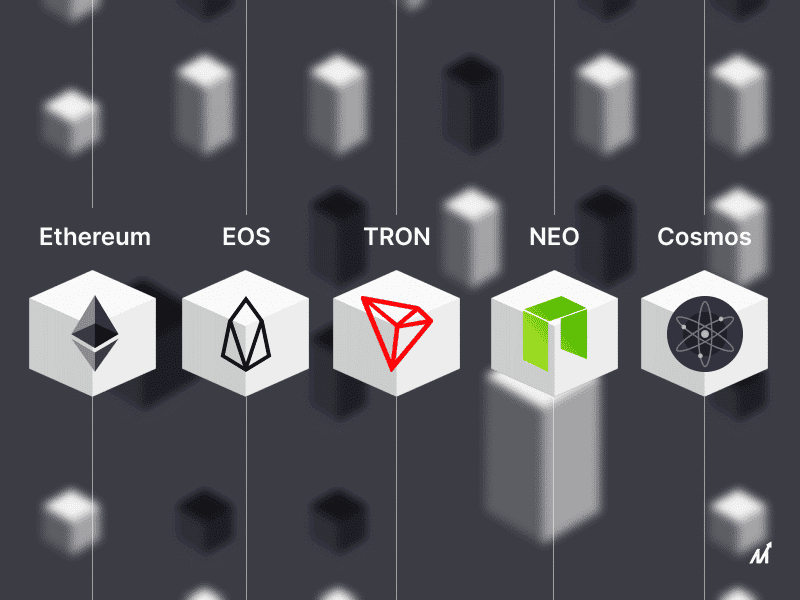
3. TRON
TRON is one of the smart contract-based blockchain networks, along with EOS and Ethereum. It is fundamentally different from other cryptocurrencies because of the decentralized entertainment investment platform that its architecture is built for. It was developed with a specific purpose in mind and had its coin, Tronix, as well as some unique protocols and a blockchain explorer (TRX). Creating a dApp using TRON Blockchain Explorer is known as TRON dApp development.
4. NEO
The finest blockchain platform for developing smart contracts and digital products is NEO. It seeks to expand into a distributed, decentralized network for non-digital assets via smart contracts. Its obvious objective is to develop into a digital substitute for existing analog asset transfers.
The NEO platform comes with a variety of development tools and techniques to help with the building of decentralized apps (dApps). You must create smart contracts and integrate them with the blockchain to create dApps on the NEO network if you’ve already finished creating, evaluating, and deploying your smart contracts.
5. Cosmos
The independent parallel blockchains that make up the decentralized peer-to-peer network known as Cosmos are all driven by BFT consensus algorithms like Tendermint consensus. In response to the Cosmos network, which acted as a middleman between many blockchains operating on its decentralized network.
On top of Tendermint Core, the Cosmos SDK provides developers with a platform for creating safe blockchain-powered decentralized apps.
Blockchain Mobile App Development: Technology Used
Blockchain applications go well beyond bitcoin and cryptocurrencies. Technology affects many industries in ways that vary from just how contracts are executed to making the government run more effectively. It can increase openness and justice while reducing businesses’ time and money. Let’s have a look at some of the technology used in the blockchain:
1. Solidity
Unquestionably, one of the most utilized languages for blockchain developers is solidity. It was created to target the Ethereum Virtual Machine and was influenced by C++, Python, and JavaScript (EVM). Solidity is inscribed and allows complicated user-defined types, libraries, and inheritance. In addition, solidity supports the OOP paradigm and is the most popular language for creating smart contracts. Blockchain developers may create apps that perform self-enforcing business logic in smart contracts using Solidity, leaving a reliable and authoritative record of all transactions. Using this makes contracts for voting, crowdsourcing, multi-signature wallets, and blind bids easier.
2. Geth
Go was used to create the Ethereum node implementation known as Geth. It is accessible through the JSON-RPC server, command-line, and interactive console interfaces. Geth may be used for Blockchain development on all three of the most popular operating systems—Windows, Mac, and Linux.
Here on Ethereum Blockchain, Geth is used for various operations, including token transfers, ether mining, the creation of smart contracts, and block history exploration. After installing Geth, you can either attach to an existing Blockchain or start creating your own. The good news is that Geth makes things easier by joining the Ethereum primary net automatically.
3. Mist
The primary Ethereum wallet created by Ethereum’s developers is called Mist. When it concerns Ethereum, you must have a specified location where you can keep your Ether tokens and carry out your smart contracts before you can begin utilizing the network. It works with Linux, Mac, and Windows (32- and 64-bit versions) (32- and 64-bit).
Remember that Mist is a full node wallet, which means you must download the complete Ethereum blockchain, which is greater than 1TB, even if it is particularly well suited for implementing smart contracts. Remembering your Mist password, a one-time installation requirement rather than something you can modify, is another crucial factor to keep in mind.
4. Solc
A C++ command-line compiler for Solidity is called Solc (Solidity Compiler). Its main objective is to translate Solidity scripts into a format that the Ethereum Virtual Machine can understand more easily. Although Solidity is a condensed, weakly typed language with a syntax like JavaScript, smart contracts created in it must be translated into a format that the EVM can quickly read and decode. Solc enters the picture at this point.
Solc comes in two savors: the C++-only Solc and the JavaScript-only Solc-js, which uses Emscripten to cross-compile the C++ source code of Solc. With the majority of Ethereum nodes, Solc is natively installed. It may also be applied to offline compilation.
5. Remix
A Blockchain tool for developing and deploying smart contracts is called Remix IDE. Remix is a tool for building, testing, troubleshooting, and deploying smart contracts built in Solidity and is written in JavaScript (so it can be viewed through any modern browser!). Both locally and within a browser are compatible with it. Remix can effortlessly link to the Ethereum blockchain with Metamask and has good documentation.
6. Metamask
A wallet called Metamask was created to operate as a link between a browser and the Ethereum Blockchain (Chrome or Firefox). It functions much like a browser extension. Metamask is a software platform that enables you to communicate with Ethereum dApps and serve Ether and other ERC-20 assets. Best of all, you can do it directly from your browser.
To exchange and purchase ETH and ERC20 tokens, Metamask may be connected to Shapeshift and Coinbase. Ether and ERC20 token keys can also be saved. Blockchain developers will find it the perfect wallet because it can communicate with several Ethereum test networks. You may use the built-in Ethereum wallet after installing the app on your browser.
7. Truffle
The Truffle Ethereum Blockchain framework creates a platform for creating Ethereum-based app development. It has a sizable library that offers tailored installations to create new smart contracts, create intricate Ethereum dApps, and assist with other difficult Blockchain development requirements. Using Chai and Mocha, Truffle can carry out automated contract testing. Additionally, it can facilitate the linking, compiling, and deployment of smart contracts. Additionally, it provides a flexible build pipeline for carrying out unique development processes.
8. Ganache
With the help of the Blockchain tool Ganache from the Truffle Suite, you may build your own personal Ethereum blockchain to test decentralized applications (dApps), run commands, and inspect the state while maintaining complete control over the chain’s functionality.
The best thing about Ganache is that it lets you carry out all the operations you would normally carry out on the main chain without charging you for them. Ganache is a convenient tool that blockchain developers use to test their smart contracts. At the same time, they are being created since it has many useful features, including powerful mining settings and a built-in block explorer.
9. Blockchain Testnet
We cannot overstate the significance of the Blockchain Testnet while discussing blockchain development. Before making dApps live, you may test them on a blockchain testnet. However, you are strongly advised to choose the appropriate Testnet for your blockchain solution for the best outcome. Blockchain testnets come in three varieties: public, private, and ganacheCLI.
Testnets are helpful since they allow you to check your dApps for faults and issues without investing much money or resources. For instance, gas is the fuel used by Ethereum to carry out various activities. Gas expenses might add up quickly if you pay for them each time you perform a test drive. Therefore, testing is now feasible as a result of Testnets.
Summing up
In our next blog, Part 2 of How to Build a Blockchain App, as a blockchain development company, we will talk about the tech aspect of the Blockchain App. Covering topics around market overview, popular companies using blockchain, and talking the various benefits that your enterprise can get from blockchain apps, the second installment of this blog will take you through the business angle of Blockchain apps.


